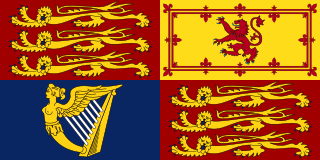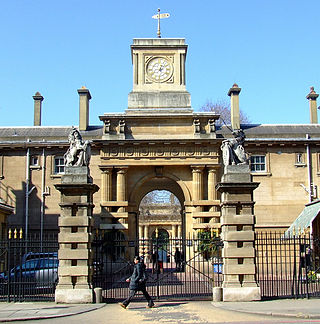Bentley Motors Limited is a British designer, manufacturer and marketer of luxury cars and SUVs. Headquartered in Crewe, England, the company was founded by W. O. Bentley (1888–1971) in 1919 in Cricklewood, North London, and became widely known for winning the 24 Hours of Le Mans in 1924, 1927, 1928, 1929 and 1930. Bentley has been a subsidiary of the Volkswagen Group since 1998 and consolidated under VW's premium brand arm Audi since 2022.

The royal standard of the United Kingdom is the banner of arms of the monarch of the United Kingdom, currently Charles III. It consists of the monarch's coat of arms in flag form, and is made up of four quarters containing the arms of the former kingdoms of England, Ireland, and Scotland. There are two versions of the banner, one used in Scotland in which the Scottish quarters take precedence, and one used elsewhere in which the English quarters take precedence.

The Royal Mews is a mews, or collection of equestrian stables, of the British royal family. In London these stables and stable-hands' quarters have occupied two main sites in turn, being located at first on the north side of Charing Cross, and then within the grounds of Buckingham Palace.

The Bentley Arnage is a full-size luxury car manufactured by Bentley Motors in Crewe, England, from 1998 to 2010. The Arnage and its Rolls-Royce-branded sibling, the Silver Seraph, were introduced in the spring of 1998. They were the first entirely new designs for the two marques since 1980.

The Rolls-Royce Silver Seraph is a large luxury automobile produced by Rolls-Royce Motors from 1998 to 2002. First unveiled on 3 March 1998 at the Geneva Motor Show, it replaced the Silver Spirit, which ended production in 1997. Silver Seraph production was discontinued when the licence to use the Rolls-Royce marque was sold to BMW, which began manufacture of an unrelated line of vehicles under a new corporation, Rolls-Royce Motor Cars.

The Gold State Coach is an enclosed, eight-horse-drawn carriage used by the British royal family. Commissioned in 1760 by Francis Rawdon-Hastings, 1st Marquess of Hastings for King George III, and designed by Sir William Chambers, it was built in the London workshops of Samuel Butler. It was commissioned for £7,562. It was built for George III's coronation in 1761, but was not ready in time; it was completed in 1762.

The Rolls-Royce Silver Shadow is a full-size luxury car produced by British automaker Rolls-Royce in various forms from 1965 to 1980. It was the first of the marque to use unitary body and chassis construction.

The King's Bargemaster is a subordinate officer of the Royal Household of the Sovereign of the United Kingdom. Until the mid-19th century, the Royal Family frequently used a royal barge for transport along the River Thames. The role of the King's Bargemaster was to oversee this. The tradition of the Bargemaster dates back to 1215, with the signing of Magna Carta at Runnymede. The role is now largely ceremonial.

The Rolls-Royce Phantom VI is a British limousine made from 1968 to 1990 by Rolls-Royce. A total of 374 Phantom VIs were made, of which fewer than 40 were manufactured in the last decade of production.

The Bentley Azure is a four-seater convertible grand tourer produced by British automobile manufacturer Bentley Motors. The first version debuted in 1995 on the Bentley Continental R platform and was made until 2003. After a three-year break, a completely new version debuted in 2006 and was produced until 2010. It was powered by a significantly updated engine and based on the newer Arnage platform.

Rolls-Royce Motors was a British luxury car manufacturer, created in 1973 during the de-merger of the Rolls-Royce automotive business from the nationalised Rolls-Royce Limited. It produced luxury cars under the Rolls-Royce and Bentley brands. Vickers acquired the company in 1980 and sold it to Volkswagen in 1998. Bentley Motors is the company's direct successor; however, BMW acquired the rights to the Rolls-Royce trademark for use on automobiles and launched a new Rolls-Royce company shortly afterwards.

The Daimler DS420, also known as the Daimler Limousine, is a limousine made by the Daimler Company between 1968 and 1992. The car was designed for official use and it was popular with chauffeur services, hoteliers and undertakers. It was used as an official state car in many countries. No other limousine model has been delivered to more reigning monarchs than the DS420, and the car is still used by the royal houses of the United Kingdom, Sweden, Denmark, and Luxembourg.
An official state car is a automobile used by a government to transport its head of state or head of government in an official capacity, which may also be used occasionally to transport other members of the government or visiting dignitaries from other countries. A few countries bring their own official state car for state visits to other countries, for instance, the United States, Russia, the United Kingdom, South Korea, Germany and Japan. It also may serve as an automotive symbol of the head of state and their country. An official state car must have adequate security, capability and stateliness for its duty. A limousine or other high-end vehicle is usually selected.

In coachbuilding, a landau is a four-wheeled carriage with a roof that can be let down. It was a luxury carriage. The low shell of the landau provides maximal visibility of the occupants and their clothing, a feature that makes a landau still a popular choice for Lord Mayors in the United Kingdom on ceremonial occasions.

The Mulsanne is a full-size luxury car that was manufactured and marketed by British automaker Bentley Motors from March 2010 to June 2020. It served as the flagship automobile for the company during its production run. Honorifically, the Mulsanne was referred to as "The Grand Bentley" during its development.

Until 2023, British manufactured cars had always been used as prime ministerial cars by the prime ministers of the United Kingdom. The cars currently used are armoured, custom built Range Rover Sentinel supercharged 5.0 litre V8 models and armoured Audi A8L models.

The Coronation Theatre: Portrait of HM Queen Elizabeth II was painted by Ralph Heimans in 2012 to mark the Diamond Jubilee of Queen Elizabeth II. While the sitting took place in Buckingham Palace, the Queen is portrayed in Westminster Abbey, standing at the centre of the Cosmati pavement where she had been crowned 60 years previously. The mosaic pavement, referred to by Shakespeare as "the floor of heaven", is rich in symbolism and was created to evoke the "eternal pattern of the universe". It has been an integral part of the coronation ceremony since Henry III of England and is where every English monarch has been crowned for the last 900 years.

The state and royal cars of the United Kingdom are kept at the Royal Mews, Buckingham Palace, where a wide range of state road vehicles are kept and maintained. The vehicles also are stored at other royal residences as required.

The Platinum Jubilee Pageant was held on Sunday, 5 June 2022 near Buckingham Palace, as part of Queen Elizabeth II's Platinum Jubilee celebrations. Conceived and directed by David Zolkwer with Pageant Master, Adrian Evans, it featured over 10,000 people from across the United Kingdom and the Commonwealth and combined street arts, music, puppets, carnival and costume to celebrate the Queen's reign, as well as honouring the collective service of people and communities across the United Kingdom.

The state hearse is a vehicle of the Royal Mews used for funerals of the British royal family. Based on a Jaguar XJ model, it was designed by the Royal Household and Jaguar Land Rover with the input of and approval from Elizabeth II and converted by UK-based coachbuilders Premiere Sheet Metal, while Wilcox Limousines created the interior, exterior trim and glazing. It was first used on 13 September 2022 to transport Queen Elizabeth II's coffin from RAF Northolt to London ahead of her lying-in-state.






















